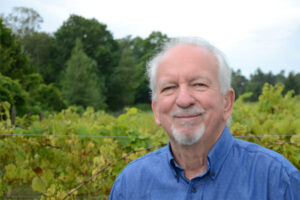What would the public, or a business, do if they didn’t have a clean, safe supply of drinking water? That’s a question posed in a new video called The Worth of Water. The video features Philip Keightley, M.Sc., P. Eng., of Bayfield. He is the Commerce representative on the Ausable Bayfield Maitland Valley Drinking Water Source Protection Committee (SPC).
The committee member wants local business owners and local residents to think about how important clean, safe drinking water is to public health and to the economy. He also gives local business owners some ideas on how they can help to protect local water sources. In this region, those sources of drinking water include groundwater in wells (drawn, for treatment, from aquifers underneath our feet) and surface water (drawn, for treatment, from Lake Huron).
“We need clean, safe water every day, in our homes and in our businesses,” he said. “We are fortunate we have a clean, safe, abundant water supply provided by our municipalities … but it’s not something we can take for granted.” In the video, he quotes Benjamin Franklin that, “When the well runs dry, we know the worth of water.”
The worth of “reliable, clean water is not just a number on your municipal water bill … the real value of water is way beyond the numbers,” he said in the video. “It’s essential to your business and to your family, so be vigilant to ensure contaminants such as waste oil, fuels, and chemicals don’t enter our water supply.”
You may watch The Worth of Water video on the local source protection region’s videos web page or on the Ausable Bayfield YouTube channel.
The new video is the twelfth video in a series, of water videos, that began in 2020. These videos have received more than 30,000 views on Facebook and YouTube.
The host of the video prompts local businesses to think about how important water is to their livelihoods. “Imagine if your local business had its source of water cut off or contaminated, how would you find a source of water to replace it?” he asks in the video. The SPC committee member also provides some history of water protection and treatment going way back to ancient Mesopotamia.
The commerce representative thanks all the local businesses who are taking positive actions including risk management plans that reduce risk to drinking water sources. “I’d like to thank all our local businesses, who keep our water safe by following the risk management plans that you developed in areas of vulnerable water supply,” he said.
The SPC commerce rep. explains how source water protection policies help to protect local drinking water. He also provides local businesses some ways they can protect drinking water sources. “History has shown us you can take actions, at work and at home, to protect our water for today, and for generations to come,” he said. “If you work with chemicals, read the label and follow instructions. Could you switch to a more environmentally friendly product?”
He urges business owners to “safely store only what you need” and to properly dispose of the rest at designated hazardous waste sites. Proper storage of chemicals, a spills response kit, a spills prevention and spills response plan, can help prevent contaminants from getting into the ground or into water sources, he said.
“You can help, at your home and your businesses,” he said in the video. “Review your practices, equipment, technology, and processes, and look for ways to reduce water use.”
The source protection committee’s outreach to the public includes videos like this new one, as well as public information campaigns like the current #WaterWednesdays social media initiative. The most important way to reach the public, according to the committee, is through direct personal outreach. In-person events include the #WaterWise events, taking place in local communities, to encourage local well owners to sample their well water. These #BestPractices education events have taken place in partnership with several local Lions Clubs as well as resident associations, local volunteers, and local public health.
To learn more, visit the Best Practices web page on the local source protection region’s sourcewaterinfo.on.ca website.

A photo of Philip Keightley, commerce representative on the source protection committee.



